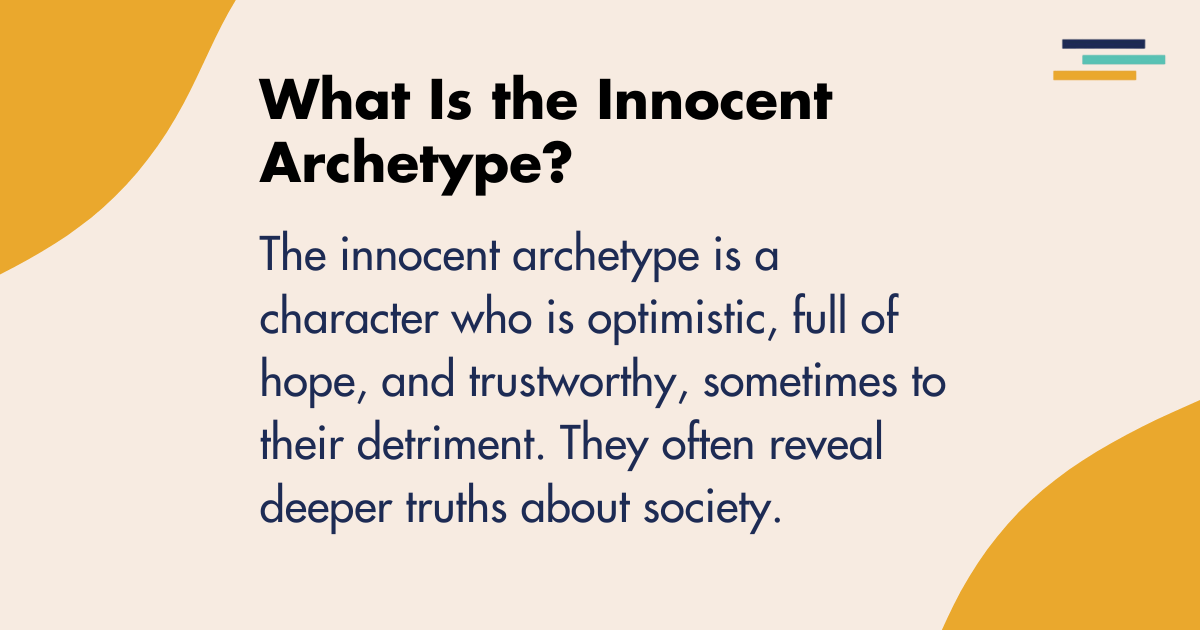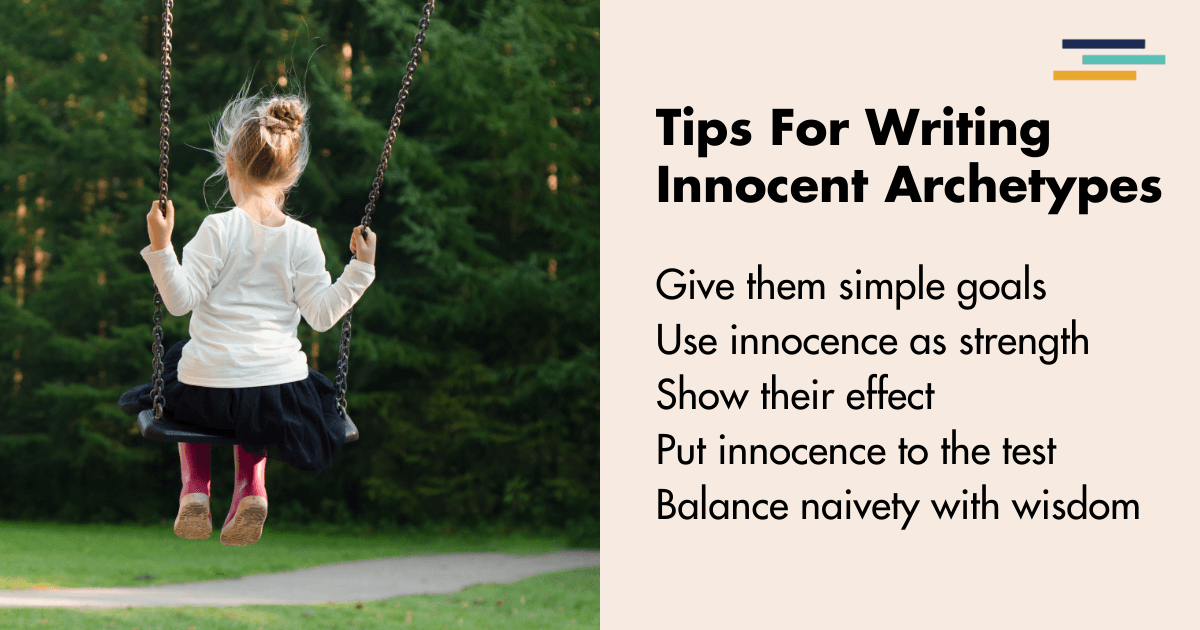
The innocent archetype is one of the most enduring and relatable figures in storytelling.
Innocent characters see the world through an optimistic lens, often untainted by cynicism or corruption. They represent purity, hope, and the desire for a better, simpler world. In this article, we’ll break down the innocent archetype, how it appears in literature and film, and provide tips on how you can write these timeless characters in your own stories.
Does that sound fun or what?
Then let’s get to it.
What Is the Innocent Archetype?
The innocent archetype embodies childlike wonder, simplicity, and a belief in the inherent goodness of people.
These characters are often optimistic and full of hope, but their naivety can sometimes lead them into challenging situations. They trust others easily, view the world through a positive lens, and are often the moral compass in a story.
But despite their simplicity, the innocent archetype can be complex and impactful, revealing deeper truths about human nature and society.
The Innocent Archetype Definition
At its core, the innocent archetype represents purity and a longing for peace.
These characters are often driven by a desire to return to or maintain a state of harmony. They resist the forces of corruption and darkness, either through their sheer belief in goodness or by influencing those around them
Innocent characters have faith in others and the world, even in the face of overwhelming evidence to the contrary. This optimism can make them both vulnerable and powerful. Vulnerable to manipulation, but powerful in their ability to inspire change.

Is Innocent a Character Trait?
Yes, innocence can certainly be a character trait, but it’s more than just naivety or a lack of experience.
Their moral purity, genuine kindness, and hopefulness, even when surrounded by negativity or hardship, define innocent characters. Their innocence isn’t just a result of ignorance. It’s often a conscious choice to see the good in people and situations.
This can make them profoundly resilient in the face of challenges, as their unwavering belief in goodness can be a source of strength.
What Makes Someone Innocent?
Innocence comes from a combination of traits: optimism, trust, and moral clarity. These characters see the world in black-and-white terms, with a strong sense of right and wrong.
They may lack experience or knowledge of the darker sides of life, but their innocence is often rooted in their unwavering belief in the possibility of a better world.
What makes an innocent character stand out is their ability to maintain that belief, even in situations where others might become jaded or corrupt.
Innocent Archetype Examples in Literature
The innocent archetype is a timeless figure in literature, representing purity, goodness, and hope.
Here are a few standout examples of innocent characters in literary works:
- Scout Finch: In To Kill a Mockingbird by Harper Lee, Scout Finch embodies the innocent archetype. As a young child, she views the world with curiosity and wonder, unaware of the deep racial prejudices around her. Through her eyes, readers experience the harsh realities of the world, making her innocence a poignant contrast to the novel’s darker themes.
- Frodo Baggins: In J. R. R. Tolkien’s The Lord of the Rings, Frodo represents innocence thrust into a world of darkness and corruption. His innate goodness and purity make him the ideal candidate to bear the burden of the One Ring, though his innocence is constantly tested throughout the journey.
- Pip: In Charles Dickens’ Great Expectations, Pip starts as an innocent and naïve boy with dreams of becoming a gentleman. As he navigates the complexities of society, his innocence is eroded, but it remains a defining characteristic that shapes his choices and interactions with others.
- Dorothy Gale: From The Wonderful Wizard of Oz by L. Frank Baum, Dorothy is the quintessential innocent character. Her journey through the magical land of Oz is driven by her desire to return home, and her pure heart helps her make friends and overcome obstacles along the way.
- Candide: In Voltaire’s Candide, the titular character is a wide-eyed optimist who believes in the philosophy that “all is for the best in the best of all worlds.” His innocence is both his strength and his downfall as he embarks on a journey filled with suffering and disillusionment.

Innocent Archetype Examples in Movies
In cinema, the innocent archetype plays a vital role in creating relatable, hopeful characters.
These characters are often the emotional heart of the story, offering a sense of optimism in the face of adversity.
Here are some well-known examples:
- Forrest Gump: In Forrest Gump, Forrest’s innocence and simple view of the world contrast with the complexity of the events he experiences. His kindness and belief in doing the right thing lead him to touch the lives of many people, making him an enduring example of the innocent archetype.
- Amélie Poulain: In Amélie, the titular character embodies innocence with her whimsical and kind-hearted approach to life. Despite her own isolation, Amélie finds joy in helping others, spreading happiness through minor acts of kindness, driven by her childlike sense of wonder and optimism.
- Buddy the Elf: In Elf, Buddy’s innocence and naivety are central to his character. Raised by elves at the North Pole, he doesn’t understand the complexities or cynicism of the human world. His wide-eyed wonder and belief in the magic of Christmas helps transform the jaded people around him.
- Chihiro Ogino: In Spirited Away, Chihiro starts as a timid, innocent child who’s thrown into a strange and dangerous world. Her innocence is tested, but it’s also her strength, helping her survive and ultimately escape the spirit world through her acts of kindness and courage.
- Paddington Bear: In Paddington, Paddington Bear’s innocence is central to the story. Despite being a bear from the jungle, his politeness, optimism, and willingness to see the good in everyone create heartwarming, comedic situations. His innocence drives the narrative and helps him find his place in a foreign world.
Tips for Writing Innocent Archetype Characters
Writing innocent characters can be a powerful way to bring hope, moral clarity, and emotional depth to your story.
However, writing them well requires balance. Too much innocence can make a character seem naïve, while too little can strip away their core identity. Here are some tips to help you write interesting innocent characters.

1. Give Them Simple Goals
Innocent characters often desire something straightforward: peace, happiness, or safety for themselves or others. Their goals are usually pure and uncomplicated, which contrasts with the more complex ambitions of other characters.
Keeping their motivations simple and rooted in goodness makes their innocence stand out in a story filled with more morally gray characters.
2. Use Innocence as a Source of Strength
Innocent characters may seem vulnerable, but their purity can also be a source of great strength.
Their optimism and belief in others can inspire those around them, making them powerful agents of change. Use their innocence as a force that drives positive outcomes, rather than just seeing it as a weakness.
3. Show How Their Innocence Affects Others
One of the most interesting aspects of the innocent archetype is how their outlook influences the people they meet.
By interacting with more jaded or morally ambiguous characters, the innocent character can serve as a mirror, reflecting the goodness in others.
Show how their optimism and trust challenge or change the attitudes of those around them.
4. Put Their Innocence to the Test
For an innocent character to be dynamic, their innocence needs to be challenged. This could come as betrayal, hardship, or exposure to harsh realities.
However, even when tested, their core belief in goodness and simplicity should remain intact. This test of innocence adds emotional depth to their character and makes their optimism more impactful.
5. Balance Naivety with Wisdom
Innocent characters are not necessarily foolish or unaware of the world’s dangers.
While they may not fully understand the darker aspects of life, they can still possess a deep moral wisdom. This balance makes them relatable and complex.
For example, they may be innocent in their worldview but have an intuitive sense of right and wrong that guides them through difficult situations.
By understanding and embracing the innocent archetype, you can craft characters that bring hope and moral clarity to your stories. Whether they are pure-hearted heroes or optimistic dreamers, these characters resonate deeply with readers, offering a reminder of the good that can still exist in the world.
And finally, always remember that the story comes first. Focus on:
- Creating engaging characters
- Penning interesting plots
- Structuring solid settings
A tool like Fictionary helps you turn your draft into an interesting story readers love. So, with a strong narrative foundation, your writing can truly shine.


